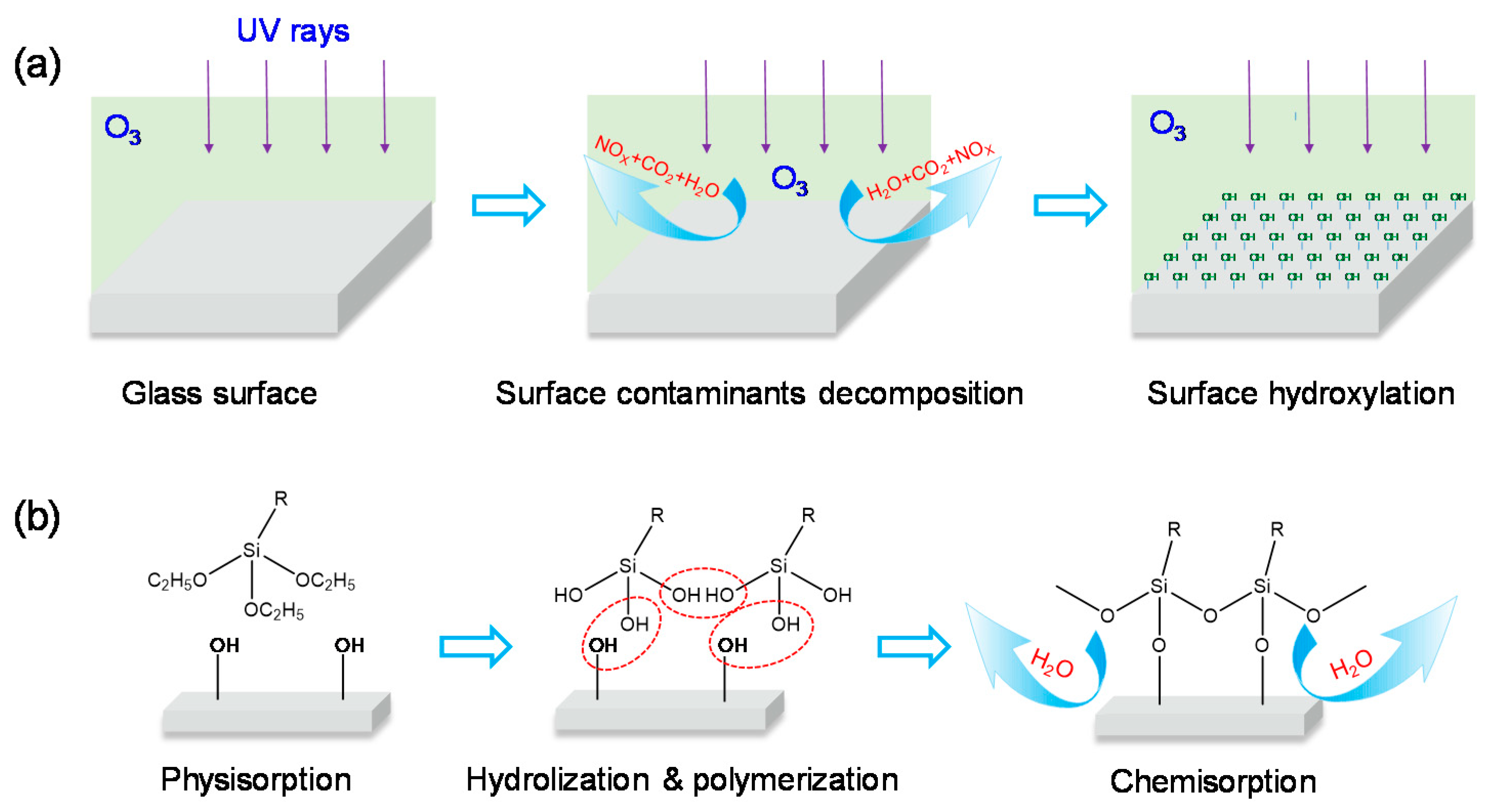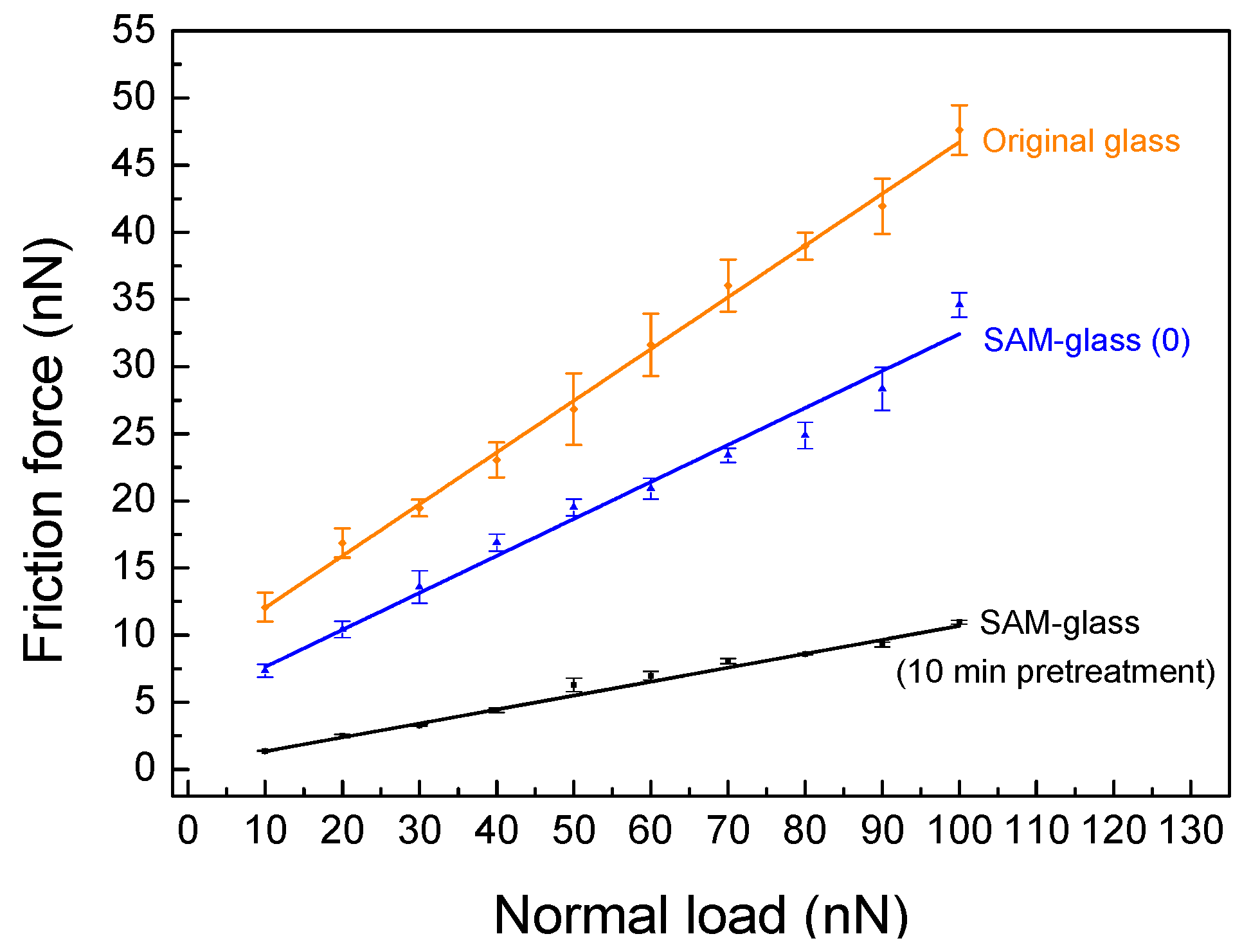UV/Ozone-Assisted Rapid Formation of High-Quality Tribological Self-Assembled Monolayer
Abstract
:1. Introduction
2. Materials and Methods
3. Results and Discussion
3.1. Pretreatment with UV/Ozone Exposure
3.2. UV/Ozone-Assisted Rapid Formation of PFDS SAM
3.3. Friction and Wear Tests
4. Conclusions
- The hydrophilicity and roughness changes of the glass surface were detected with UVO treatment time, and hydrophilic glass with the smallest surface roughness was prepared at 10 min UVO treatment.
- After deposition in PFDS solution for 2 h, high-quality PFDS SAM was rapidly formed on a 10 min UVO-treated glass surface.
- Compared with original glass surface and film-deposited glass without pretreatment, SAM-coated glass with 10 min pretreatment possessed excellent lubrication and antiwear properties.
Author Contributions
Funding
Conflicts of Interest
References
- Bhushan, B.; Kasai, T.; Kulik, G.; Barbieri, L.; Hoffmann, P. AFM study of perfluoroalkylsilane and alkylsilane self-assembled monolayers for anti-stiction in MEMS/NEMS. Ultramicroscopy 2005, 105, 176–188. [Google Scholar] [CrossRef]
- Cheng, H.; Hu, Y. Influence of chain ordering on frictional properties of self-assembled monolayers (SAMs) in nano-lubrication. Adv. Colloid Interface 2012, 171–172, 53–65. [Google Scholar] [CrossRef] [PubMed]
- Liu, X.; Shan, D.; Song, Y.; Han, E. Effect of assembled time on the corrosion behaviors of SAMs film on the AM60B alloy and its assembled mechanism. Mater. Chem. Phys. 2015, 149–150, 559–565. [Google Scholar] [CrossRef]
- Yu, B.; Qian, L.; Yu, J.; Zhou, Z. Effects of tail group and chain length on the tribological behaviors of self-assembled dual-layer films in atmosphere and in vacuum. Tribol. Lett. 2009, 34, 1–10. [Google Scholar] [CrossRef]
- Huo, L.; Du, P.; Zhang, K.; Liu, P.; Zhou, H. Self-assembled monolayer of multiply-alkylated cyclopentenes on silicon via thiol-ene “click” reaction and its self-lubricating properties. Appl. Surf. Sci. 2019, 477, 96–103. [Google Scholar] [CrossRef]
- Li, G.; Zheng, S.; Bai, C.; Li, X.; Cheng, C. Self-assembled monolayer of mica coating using organobisphosphonic acid. Appl. Surf. Sci. 2018, 457, 449–455. [Google Scholar]
- Hosseinpour, S.; Forslund, M.; Johnson, C.M.; Pan, J.; Leygraf, C. Atmospheric corrosion of Cu, Zn, and Cu–Zn alloys protected by self-assembled monolayers of alkanethiols. Surf. Sci. 2016, 648, 170–176. [Google Scholar] [CrossRef]
- Kondo, R.; Nakajima, D.; Kikuchi, T.; Natsui, S.; Suzuki, R.O. Superhydrophilic and superhydrophobic aluminum alloys fabricated via pyrophosphoric acid anodizing and fluorinated SAM modification. J. Alloys Compd. 2017, 725, 379–387. [Google Scholar] [CrossRef]
- Lee, H.C.; Jo, M.; Lim, H.; Yoo, M.S.; Lee, E.; Nguyen, N.N.; Han, S.Y.; Cho, K. Toward near-bulk resistivity of Cu for next-generation nano-interconnects: Graphene-coated Cu. Carbon 2019, 149, 656–663. [Google Scholar] [CrossRef]
- Kohli, R.; Mittal, K.L. Developments in Surface Contamination and Cleaning: Applications of Cleaning Techniques; Elsevier: Amsterdam, The Netherlands, 2019. [Google Scholar]
- Wang, H.; Yu, B.; Jiang, S.; Jiang, L.; Qian, L. UV/ozone-assisted tribochemistry-induced nanofabrication on Si(100) surface. RSC Adv. 2017, 7, 39651–39656. [Google Scholar] [CrossRef]
- Wu, L.; Fan, Z.; Peng, Y.; Zhou, H.; Wang, H.; Yu, B.; Qian, L. Rapid nanofabrication via UV-assisted selective etching on GaAs without templates. Chem. Phys. Lett. 2019, 717, 152–157. [Google Scholar] [CrossRef]
- Kimura, Y.; Kasai, K.; Miyata, S. Feeder-free culture for mouse induced pluripotent stem cells by using UV/ozone surface-modified substrates. Mat. Sci. Eng. C-Mater. 2018, 92, 280–286. [Google Scholar] [CrossRef] [PubMed]
- Ge, D.; Li, Y.; Yang, L.; Fan, Z.; Liu, C.; Zhang, X. Improved self-assembly through UV/ozone surface-modification of colloidal spheres. Thin Solid Films 2011, 519, 5203–5207. [Google Scholar] [CrossRef]
- Boinovich, L.B.; Domantovskiy, A.G.; Emelyanenko, A.M.; Pashinin, A.S.; Ionin, A.A.; Kudryashov, S.I.; Saltuganov, P.N. Femtosecond laser treatment for the design of electro-insulating superhydrophobic coatings with enhanced wear resistance on glass. ACS Appl. Mater. Int. 2014, 6, 2080–2085. [Google Scholar] [CrossRef] [PubMed]
- Monteiro, M.C.O.; Schmuki, P.; Killian, M.S. Tuning Anatase Surface Reactivity toward Carboxylic Acid Anchor Groups. Langmuir 2017, 33, 13913–13922. [Google Scholar] [CrossRef]
- Li, J.; Wang, N.; Yan, H.; Ji, S.; Zhang, G. Designing superhydrophobic surfaces with SAM modification on hierarchical ZIF-8/polymer hybrid membranes for efficient bioalcohol pervaporation. RSC Adv. 2014, 4, 59750–59753. [Google Scholar] [CrossRef]
- Cichomski, M. Tribological investigation of perfluoroalkysilanes monolayers deposited on titanium surface. Mater. Chem. Phys. 2012, 136, 498–504. [Google Scholar] [CrossRef]
- Wang, B.; Hua, Y.; Ye, Y.; Chen, R.; Li, Z. Transparent superhydrophobic solar glass prepared by fabricating groove-shaped arrays on the surface. Appl. Surf. Sci. 2017, 426, 957–964. [Google Scholar] [CrossRef]
- Cichomski, M.; Kośla, K.; Pawlak, W.; Kozłowski, W.; Szmaja, W. Stability and tribological investigations of 1H,1H,2H,2H-perfluoroalkyltrichlorosilane on titania surface. Tribol. Int. 2014, 77, 1–6. [Google Scholar] [CrossRef]
- Wu, L.; Cai, L.; Liu, A.; Wang, W.; Yuan, Y.; Li, Z. Self-assembled monolayers of perfluoroalkylsilane on plasma-hydroxylated silicon substrates. Appl. Surf. Sci. 2015, 349, 683–694. [Google Scholar] [CrossRef]
- Bhushan, B. Nanotribology and Nanomechanics: Self-Assembled Monolayers (SAMs) for Nanotribology and Surface Protection; Springer: Berlin/Heidelberg, Germany, 2017. [Google Scholar]
- Fu, Y.; Qui, H.; Liao, K.; Lue, S.; Hu, C.; Lee, K.R.; Lai, J. Effect of UV-ozone treatment on poly(dimethylsiloxane) membranes: Surface characterization and gas separation performance. Langmuir 2010, 26, 4392–4399. [Google Scholar] [CrossRef] [PubMed]
- Lu, H.; Yan, W.; Liu, Z.; Li, J. Hydrophilic surface modification of polydimethylsiloxane with UV/ozone treatment. Spectrosc. Spect. Anal. 2016, 36, 1033–1037. (In Chinese) [Google Scholar]
- Uehara, T.M.; de Aguiar, H.B.; Bergamaski, K.; Miranda, P.B. Adsorption of alkylthiol self-assembled monolayers on gold and the effect of substrate roughness: A comparative study using scanning tunneling microscopy, cyclic voltammetry, second-harmonic generation, and sum-frequency generation. J. Phys. Chem. C 2014, 118, 20374–20382. [Google Scholar] [CrossRef]
- Aswal, D.K.; Lenfant, S.; Guerin, D.; Yakhmi, J.V.; Vuillaume, D. Self assembled monolayers on silicon for molecular electronics. Anal. Chim. Acta 2006, 568, 84–108. [Google Scholar] [CrossRef]
- Hong, H.; Park, W. A study of adsorption kinetics and thermodynamics of ω- mercaptoalkylhydroquinone self-assembled monolayer on a gold electrode. Electrochim. Acta 2005, 51, 579–587. [Google Scholar] [CrossRef]
- Choi, J.; Kawaguchi, M.; Kato, T. Self-assembled monolayer formation on magnetic hard disk surface and friction measurements. J. Appl. Phys. 2002, 91, 7574–7576. [Google Scholar] [CrossRef]
- Kang, C.; Lu, H.; Yuan, S.; Hong, D.; Yan, K.; Liang, B. Superhydrophilicity/superhydrophobicity of nickel micro-arrays fabricated by electroless deposition on an etched porous aluminum template. Chem. Eng. J. 2012, 203, 1–8. [Google Scholar]
- Yuan, S.; Pehkonen, S.O.; Liang, B.; Ting, Y.; Neoh, K.G.; Kang, E. Superhydrophobic fluoropolymer-modified copper surface via surface graft polymerisation for corrosion protection. Corros. Sci. 2011, 53, 2738–2747. [Google Scholar] [CrossRef]
- Yue, P. Modelling of kinetics and reactor for water purification by photo-oxidation. Chem. Eng. Sci. 1993, 48, 1–11. [Google Scholar] [CrossRef]
- Zhou, M.; Xiong, X.; Jiang, B.; Weng, C. Fabrication of high aspect ratio nanopillars and micro/nano combined structures with hydrophobic surface characteristics by injection molding. Appl. Surf. Sci. 2018, 427, 854–860. [Google Scholar] [CrossRef]
- Varenberg, M.; Etsion, I.; Halperin, G. An improved wedge calibration method for lateral force in atomic force microscopy. Rev. Sci. Instrum. 2003, 74, 3362–3367. [Google Scholar] [CrossRef]
- Yu, B.; Qian, L.; Dong, H.; Yu, J.; Zhou, Z. Friction-induced hillocks on monocrystalline silicon in atmosphere and in vacuum. Wear 2010, 268, 1095–1102. [Google Scholar] [CrossRef]
- Chen, L.; Li, N.; Yang, B.; Zhang, J. A comparative study of the tribological behaviors of CH3- and CF3-terminated bilayer films. J. Adhes. Sci. Technol. 2016, 30, 677–689. [Google Scholar] [CrossRef]
- Johnson, K.L. Contact Mechanics; Cambridge University Press: Cambridge, UK, 1985. [Google Scholar]
- Satyanarayana, N.; Sinha, S.K. Tribology of PFPE over coated self-assembled monolayers deposited on Si surface. J. Phys. D Appl. Phys. 2005, 38, 3512–3522. [Google Scholar]






© 2019 by the authors. Licensee MDPI, Basel, Switzerland. This article is an open access article distributed under the terms and conditions of the Creative Commons Attribution (CC BY) license (http://creativecommons.org/licenses/by/4.0/).
Share and Cite
Fan, Z.; Zhi, C.; Wu, L.; Zhang, P.; Feng, C.; Deng, L.; Yu, B.; Qian, L. UV/Ozone-Assisted Rapid Formation of High-Quality Tribological Self-Assembled Monolayer. Coatings 2019, 9, 762. https://doi.org/10.3390/coatings9110762
Fan Z, Zhi C, Wu L, Zhang P, Feng C, Deng L, Yu B, Qian L. UV/Ozone-Assisted Rapid Formation of High-Quality Tribological Self-Assembled Monolayer. Coatings. 2019; 9(11):762. https://doi.org/10.3390/coatings9110762
Chicago/Turabian StyleFan, Zhitao, Chao Zhi, Lei Wu, Pei Zhang, Chengqiang Feng, Liang Deng, Bingjun Yu, and Linmao Qian. 2019. "UV/Ozone-Assisted Rapid Formation of High-Quality Tribological Self-Assembled Monolayer" Coatings 9, no. 11: 762. https://doi.org/10.3390/coatings9110762
APA StyleFan, Z., Zhi, C., Wu, L., Zhang, P., Feng, C., Deng, L., Yu, B., & Qian, L. (2019). UV/Ozone-Assisted Rapid Formation of High-Quality Tribological Self-Assembled Monolayer. Coatings, 9(11), 762. https://doi.org/10.3390/coatings9110762



